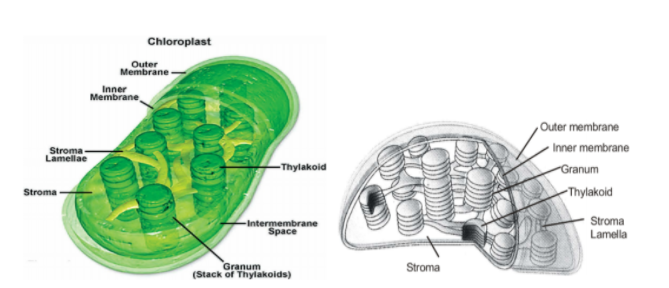
Describe the ultrastructure of chloroplast.
Answer
581.4k+ views
Hint: Granum is the site of light reaction while stroma is the site of dark reaction of photosynthesis. Mesophyll cell of the leaves contains the chloroplast. Chloroplast appears green in colour due to the presence of chlorophyll a and b pigment.
Complete answer: Chloroplast is the double membraned, self-replicating, DNA containing and semi autonomous organelle. It is present in higher plants and green algae. It contains a green pigment, called chlorophyll, which is essential for the process of photosynthesis. So, chloroplasts are also known “kitchen of the cell”.
A green mesophyll cell contains 20-40 chloroplasts. The size of chloroplast is 4–6 µm × 2–4 µm. The shape of chloroplast can be cup-shaped, spiral, discoidal, reticulate, etc.
Chloroplast is a type of plastid that is involved in preparation and storage of food. It is green in colour due to the presence of chlorophyll a and b.
Each chloroplast contains three parts – envelope, stroma and lamellar system.
(a) Envelope: It contains two lipoprotein membranes. A space of 100-200Å is present between these two membranes.
The outer membrane is freely permeable while the inner membrane is selectively permeable.
(b) Stroma: It is highly proteinaceous. It contains double stranded DNA, RNA, 70s Ribosomes, proteins, lipids, chlorophyll, minerals and enzymes required for the process of photosynthesis and granules called as grana. RuBisCO is the most abundant enzyme on the earth, which is required for photosynthesis.
(c) Lamellar system: It consists of flattened disc-like structures known as thylakoids, which are stacked to form granum. Thylakoids consist of chlorophyll, carotenoids and phospholipids.
Thylakoids are the structural unit of chloroplast.
Each chloroplast has 40-60 grana. Two grana are interconnected by a long tube-like structure known as stroma lamellae.
Granum is the site of light reaction during photosynthesis, while stroma is the site of dark reaction during photosynthesis.
The main function of chloroplast is trapping sunlight and utilizing it to prepare food for the plant.

Note: Chloroplasts are known as semi-autonomous organelles as they contain double stranded DNA, RNA, ribosomes and protein synthesis machinery.
Chloroplasts and mitochondria are considered to have originated from the prokaryotic cells due to presence of circular double stranded DNA and 70s ribosomes.
Complete answer: Chloroplast is the double membraned, self-replicating, DNA containing and semi autonomous organelle. It is present in higher plants and green algae. It contains a green pigment, called chlorophyll, which is essential for the process of photosynthesis. So, chloroplasts are also known “kitchen of the cell”.
A green mesophyll cell contains 20-40 chloroplasts. The size of chloroplast is 4–6 µm × 2–4 µm. The shape of chloroplast can be cup-shaped, spiral, discoidal, reticulate, etc.
Chloroplast is a type of plastid that is involved in preparation and storage of food. It is green in colour due to the presence of chlorophyll a and b.
Each chloroplast contains three parts – envelope, stroma and lamellar system.
(a) Envelope: It contains two lipoprotein membranes. A space of 100-200Å is present between these two membranes.
The outer membrane is freely permeable while the inner membrane is selectively permeable.
(b) Stroma: It is highly proteinaceous. It contains double stranded DNA, RNA, 70s Ribosomes, proteins, lipids, chlorophyll, minerals and enzymes required for the process of photosynthesis and granules called as grana. RuBisCO is the most abundant enzyme on the earth, which is required for photosynthesis.
(c) Lamellar system: It consists of flattened disc-like structures known as thylakoids, which are stacked to form granum. Thylakoids consist of chlorophyll, carotenoids and phospholipids.
Thylakoids are the structural unit of chloroplast.
Each chloroplast has 40-60 grana. Two grana are interconnected by a long tube-like structure known as stroma lamellae.
Granum is the site of light reaction during photosynthesis, while stroma is the site of dark reaction during photosynthesis.
The main function of chloroplast is trapping sunlight and utilizing it to prepare food for the plant.

Note: Chloroplasts are known as semi-autonomous organelles as they contain double stranded DNA, RNA, ribosomes and protein synthesis machinery.
Chloroplasts and mitochondria are considered to have originated from the prokaryotic cells due to presence of circular double stranded DNA and 70s ribosomes.
Recently Updated Pages
Why are manures considered better than fertilizers class 11 biology CBSE

Find the coordinates of the midpoint of the line segment class 11 maths CBSE

Distinguish between static friction limiting friction class 11 physics CBSE

The Chairman of the constituent Assembly was A Jawaharlal class 11 social science CBSE

The first National Commission on Labour NCL submitted class 11 social science CBSE

Number of all subshell of n + l 7 is A 4 B 5 C 6 D class 11 chemistry CBSE

Trending doubts
Differentiate between an exothermic and an endothermic class 11 chemistry CBSE

10 examples of friction in our daily life

One Metric ton is equal to kg A 10000 B 1000 C 100 class 11 physics CBSE

Difference Between Prokaryotic Cells and Eukaryotic Cells

State the laws of reflection of light

Explain zero factorial class 11 maths CBSE




